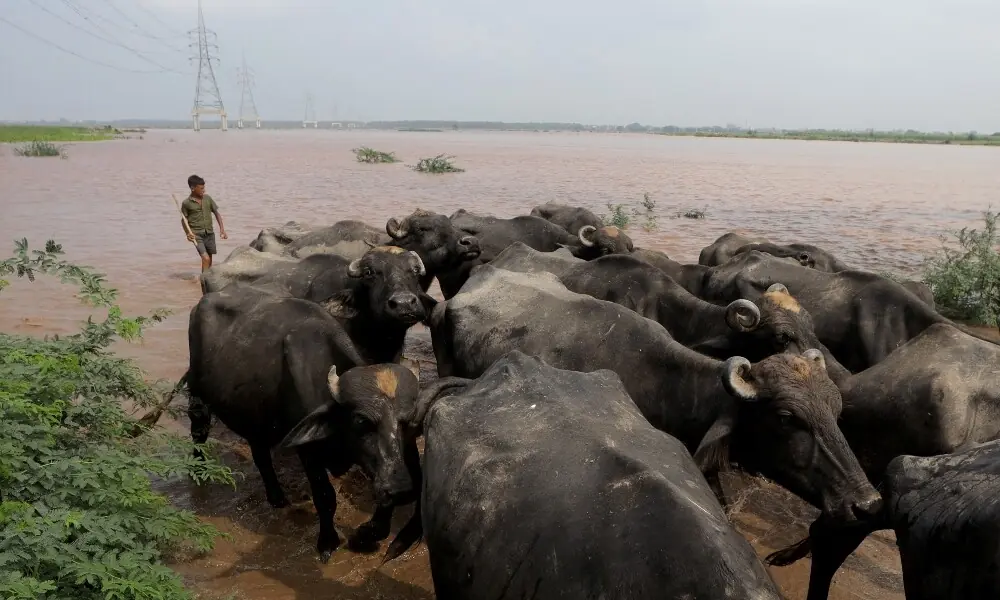The unprecedented outbreak of debilitating transboundary foot and mouth disease has dug economic graves for our indigenous dairy farmers, who have been toiling relentlessly without respite to make both ends meet. Nearly all the dairy colonies in Karachi, particularly the Bilal Cattle Colony, Nagori Society and Landhi Cattle Colony, have been badly afflicted with this appalling disease.
The FMD fulminated first at Bilal Cattle Colony, snowballed at a faster rate and spilled over into other cattle colonies. No sooner the news of the eruption of FMD transpired than Haji Mohammed Akhter, President Dairy Farmers' Association along with Haji Mohammad Rashed, Finance Secretary, rushed to the Bilal Cattle Colony and visited all the affected sheds.
Many cattle have breathed their last and those affected with the disease have become from moribund. The dairy farmers have incurred a big financial loss.
FMD is the most important restraint to international trade in animals and animal products. Consequently, large sums of money have been invested to control the illness and funds have some into eradication programmes and also into research. As a result more is known about the FMD virus than about almost any other animal infection.
It generally produces severe disease in cattle and pigs. FMD is highly infectious, spreads rapidly throughout the animal populations and over long distances on the wind and called transboundary disease and hence it is difficult and costly to control. Also because of its damaging and devastating effect on cattle, a great deal of effort and money has been spent in the European countries keeping it out of large areas of the world.
EARLY CLINICAL SIGNS: In cattle the early clinical signs are much more definitive and suggestive than in pigs. For example in a dairy herd several cows may suddenly show depressed milk yield, go off their feed, run a fever, have a dramatic drop in milk yield, and a little later start salivating profusely, the saliva running from their mouths (slavering). If such signs are observed, become active, contact Aamir Sajjad, Office Incharge, Dairy Farmers Association, Phone: 5083018, E.mail: dfa_lcc@yahoo.com.
If the cows have started salivating and smacking lips, vesicles are noticed on the lips, on the teats and around the coronets, the areas above hooves - the worst fears may become true. The probability is that your cattle herd has been infected too.
In buffaloes early signs are lameness, a drop in food consumption and some buffaloes appear depressed and have fevers of about 40.5ºC (105ºF). In calves sudden death due to cardiac failure is common. What should make you strongly suspicious is the appearance a little later of vesicles upto 30 diameter. They are most plentiful around the coronets but are less plentiful on lips although they may be seen there first.
They often appear on the teats of recently furrowed cattle. By then the cows or buffaloes and some of the other cattle may be dribbling saliva and chomping their jaws.
Within 24 hours many of the vesicles will have burst. On the lips and teats they may leave shallow erosions but on the coronets of the feet secondary infection and trauma may convert them into raw jagged-edged ulcers.
In endemic areas where vaccination is carried out routinely the disease is not a serious economic problem in cattle herds. In fringe areas, particularly where vaccination is not allowed (eg in the EU) it is a serious problem because the herd will almost certainly be slaughtered out and although compensation is likely to be paid, the farm cannot be restocked for at least six weeks. It is therefore out of production and in a negative cash flows for a long time.
DIAGNOSIS
RAPID ACCURATE DIAGNOSIS IS ESSENTIAL: The samples collected are blood and pieces of the skin that overlay the blisters plus vesicular fluid if this is available. This will be done by the research team working for Dairy Farmers' Association under the guidance of Dr Qurban Ali, Chief Scientific Officer, NVL, Islamabad. Once the samples have been received by the research team, diagnosis is fairly rapid.
Tests called ELISAs are used for virus identification and if it is FMD they also indicate what serotype it is. The virus may also be grown in cell culture and the identification confirmed by other tests. A molecular genetic test called a PCR (polymerase chain reaction) may also be used to "fingerprint" the virus.
The gene (genome or RNA) of FMD repeatedly undergoes minor changes as the virus spreads through animal populations so by identifying the precise sequence in the gene the laboratory staff is able to make an assumption where it may have come from by the most recent isolate with a similar sequence.
TREATMENT:
-- There is no treatment. Animals should be destroyed.
-- Management control and prevention.
-- Vaccination (where applicable).
-- In endemic and high risk areas routine vaccination may be practised mainly to protect the breeding stock.
-- FMD vaccines are produced in cell suspension cultures and inactivated by ethylenamine derivatives. An adjuvant is added to make them more potent. Oily adjuvants are used in swine.
SEROTYPES - THERE ARE 7 MAIN SEROTYPES: A, O, C, SAT 1, SAT 2, SAT 3 and Asia 1. There are also many strains within serotypes. Careful selection of the strains for incorporation in vaccines is essential to ensure they are effective.
HOW TO PROTECT YOUR FARM: The following points will provide information on preventative measures on how to protect your farm against foot and mouth disease. Further measures apply if your farm is in a declared infected area.
THE FOLLOWING MEASURES SHOULD BE FOLLOWED:
-- You should ensure the highest standards of hygiene for all movements on and off your farm.
-- Have only one combined entrance and exit. Display the name of the farm and the telephone number on the gate. Keep the gate locked.
-- Provide a means of contact between farm entrance and house for essential callers, eg a bell or a gong. Supply a tub of disinfectant, a brush for scrubbing footwear and a spray pump. Keep the disinfectant solution clean and renew it daily.
-- All vehicles entering and leaving the premises should have their wheels sprayed with approved disinfectant.
-- Stop all non-essential vehicles and visitors from entering the farm and arrange whenever possible for collection and delivery of supplies to take place at farm boundary.
-- Keep a record of all deliveries. In the event of disease being confirmed this may help in epidemiological investigations. Where possible, house all the animals or keep them away from the perimeter of your farm.
-- Ensure you complete all records of stock movements as required by existing legislation.
-- Each farm must be treated as a separate unit. Make separate arrangements for labour, management and feeding.
-- Keep dogs, cats and poultry under control.
-- Make every effort to destroy rats and other vermin. They may spread the disease.
-- Keep your stock away from household waste, bones or swill.
-- Limit contact with other peoples livestock and with other keepers of livestock.
-- Should you have any contact with them, before you go near your own animals, disinfect your footwear, change your clothes and wash with hot water and soap, including your hair. Any item or object that may have had contact with the disease must also be disinfected.
-- Healthcare officials are aware of precautions necessary and you must not delay seeking medical assistance if needed.
CLINICAL SIGNS: The interval between exposure to infection and the appearance of symptoms varies between twenty-four hours and ten days, or even longer. The average time is three to six days.
CATTLE:
-- Slobbering and smacking lips.
-- Shivering.
-- Tender and sore feet.
-- Reduced milk yield.
-- Sores and blisters on feet.
-- Raised temperature.
SPREAD OF DISEASE:
-- Foot-and-mouth disease is extremely infectious. A very small quantity of the virus is capable of infecting an animal, and the disease could spread throughout the country if no attempt is made to control it.
-- Airborne spread of the virus can take place and under favourable climatic conditions the disease may spread to considerable distances by this route.
-- The virus is present in great quantity in the fluid from the blisters, and it can also occur in the saliva, exhaled air, milk and dung. Any of these can be a source of infection to other stock. At the height of the disease, virus is present in the blood and all parts of the body.
-- Heat, sunlight and disinfectants will destroy the virus, whereas cold and darkness tend to keep it alive. Under favourable conditions it can survive for long periods.
-- Animals pick up the virus either by direct or indirect (airborne) contact with an infected animal, or by contact with foodstuffs or other things which have been contaminated by such an animal, or by eating or coming into contact with some part of an infected carcase.
-- Cattle trucks, lorries, market places, and loading ramps - where infected animals may have been present - are sources of infection until disinfected. Roads may also become contaminated, and virus may be picked up and carried on the wheels of passing vehicles such as delivery lorries, milk tankers etc.
-- Any person who has attended on diseased animals can spread the disease; and dogs, cats, poultry, wild game and vermin may also carry the infected material.
(The writer is a microbiologist of the Dairy Farmers' Association of Karachi)
BR100
15,085
Increased By
112.5 (0.75%)
BR30
44,012
Increased By
987.7 (2.3%)
KSE100
148,618
Increased By
1274.3 (0.86%)
KSE30
45,248
Increased By
370.7 (0.83%)





















Comments
Comments are closed.